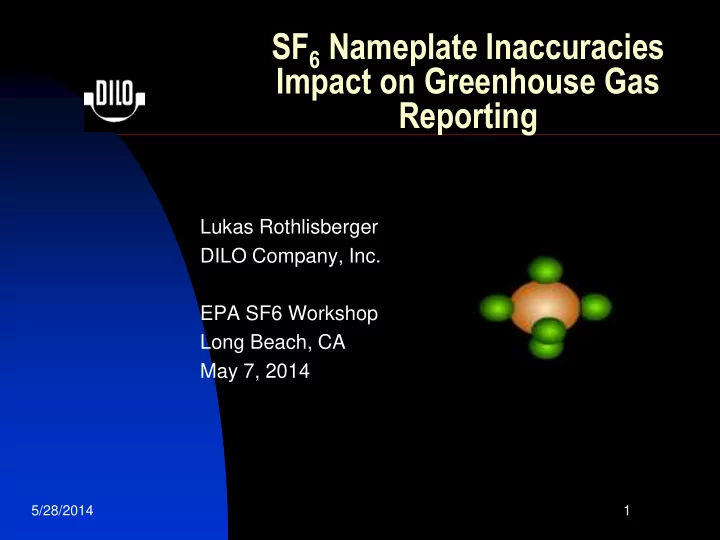

SF 6 Nameplate Inaccuracies Impact on Greenhouse Gas Reporting Lukas Rothlisberger DILO Company, Inc. EPA SF6 Workshop Long Beach, CA May 7, 2014 5/28/2014 1
Topics of Discussion General Information Mandatory Greenhouse Gas Reporting Rule Possible Reasons for Nameplate Inaccuracies Eliminating Emissions Determining Exact amount of SF 6 in any Vessel 5/28/2014 2
Environmental Considerations 5/28/2014 3
Environmental Considerations GHG Comparison 5/28/2014 4
Environmental Considerations GHG Emissions 5/28/2014 5
Environmental Regulations Mandatory Greenhouse Gas Reporting Rule (40 CFR Part 98) Subpart DD (Users of Electrical Equipment) Subpart SS (OEM’s) USEPA Requires users with at least 17,820 lbs nameplate capacity to report emissions annually Certain States have similar mandatory reporting requirements CA (Air Resources Board) MA (Proposed) 5/28/2014 6
State of California / CARB Establishes an annual maximum emission rate at 10% of nameplate capacity Requires GIE owners to reduce their annual emission rate by 1% per year over a ten year period from 2011 to 2020 Beginning in 2020, sets maximum emission rate not to exceed 1% 5/28/2014 7
Mass Balance Equation User Emissions = (Decrease in Storage Inventory) + (Acquisitions) – (Disbursements) – (Net increase in Total Nameplate Capacity of Equipment Operated) Nameplate capacity refers to the full and proper charge of equipment, in pounds (lbs) of SF 6 , rather than actual charge, which may (amongst other things) reflect leakage 5/28/2014 8
Under / Over Estimation Underestimation True value is 300 lbs / Nameplate is 280 lbs = Negative emission of 20 lbs Overestimation True value is 280 lbs / Nameplate is 300 lbs = “Phantom Emission” of 20 lbs Anecdotal evidence suggests that a large percentage of GIE will fall into either of the above categories 5/28/2014 9
Incorrect Nameplate? SF 6 Leakage from GIE GIE Under/Over filled SF 6 Emission during Recovery GIE Inaccurate Nameplate 5/28/2014 10
SF 6 Leakage from GIE Leakage will result in GIE containing lower amount of SF 6 compared to nameplate Actual leak will/should be reported as emission Will create issue if user isn’t aware of leak Slow leak on large volume vessel Leak hasn’t resulted in noticeable pressure drop or low pressure alarm 5/28/2014 11
Under/Over Fill GIE is generally filled using temperature/pressure curve 5/28/2014 12
Under/Over Fill Accidental or Intentional (Over Fill Only) Any deviation of temperature/pressure reading will lead to discrepancy Example: Vessel containing 200 lbs @ 87 PSIG – if originally only filled to 85 PSIG = 4 lbs Phantom Emission. Result of inaccurate temperature or pressure measurement Direct vs Equipment assisted fill 5/28/2014 13
Direct vs Equipment Assisted Filling GIE is filled either directly from cylinders or through Recovery System that may contain heaters/evaporators Operators utilizing GIE OEM temperature/pressure curve generally assume ambient = gas temperature Controlled tests using the following equipment: 1,000 l ASME Pressure Tank Precision Pressure Gauge K040R13 Mass flow scale B152R41 Cylinder weighing scale D-230-R002 5/28/2014 14
Filling Procedure 1,000 l tank filled to 80 PSIG Filling directly from cylinder required 88.97 lbs SF 6 gas Heat loss during vaporization Temperatures < 25 F possible Filling through heater/evaporator required 87.50 lbs SF 6 gas Gas temperature 90 F Alternate equipment use resulted potential phantom emission of 1.47 lbs / 1.66 % 5/28/2014 15
Measuring / Weighing Issues Weight Scale Inaccuracies Use Weight Scales with specified accuracy and calibrate at required intervals Residual Recovery System Pressure Utilize Mass Flow Scales at GIE Incorrect Cylinder TW Stamps Weigh and re-stamp empties during re-test 5/28/2014 16
Residual Recovery System Pressure 5/28/2014 17
Measuring / Weighing Issues Gauges without displayed value Requires external gauge for exact/accurate measurement Commonly used on HV and MV Equipment Gauges providing PSIG / bar / kPa reading preferred 5/28/2014 18
SF 6 Recovery Emission Failure to reach an acceptable blank off pressure (Recovery System limitation or operator error) will result in SF 6 emission Resulting emission easy to calculate Recommended blank off pressure 3.5 Torr / mmHg minimum Guarantees > 99.9% SF 6 Recovery 5/28/2014 19
SF 6 Recovery Emission Residual Pressure 75 PSIG 0 PSIG 3.5 Torr 5/28/2014 20
SF 6 Recovery Emission Determining Recovery % Circuit breaker containing 200 lbs of SF 6 @ 80 PSIG Blank-off pressure 3.5 Torr 99.93% recovery / SF 6 emission = 0.14 lbs Blank-off pressure 200 Torr 95.92% recovery / SF 6 emission = 8.16 lbs 5/28/2014 21
Verifying Nameplate Test Subjects Sample group 23 HV Circuit Breakers Temperature/Pressure deviation < 1% Non leaking > 2 years in service w/o top off Verified by blanking off < 1 Torr and performing raise test OEM Specified Nameplate capacity Minimum Nameplate capacity 25 lbs 5/28/2014 22
Inaccurate Nameplate Under/Over Fill, Leakage, Recovery Emission were all eliminated for testing Possible reasons for wrong nameplate: Inaccurate calculation / measurement Design change affecting internal volume Human error 5/28/2014 23
Determine Exact SF 6 Weight Variables needed: Initial System Pressure / PI - a Final System Pressure / PF - b Amount (in lbs) of SF6 Recovered - c Formula: 5/28/2014 24
Required Equipment Precision gauge, mass flow scale, compressor, sample cylinder Recovery < 2 lbs or 2 PSIG 15 min per GIE – Equipment to be de-energized Temperature Irrelevant 5/28/2014 25
Conclusions / Recommendations Discrepancies in installed GIE highly likely Actual discrepancies > 1% very likely the norm Current data (Emission rate compared to Nameplate) questionable at best Entities required to report need ability to correct baseline numbers Convert all SF6 handling (Receiving, filling/top off) to True Mass Monitoring Check Temperature/Pressure before degassing Retest cylinders to include accurate TW stamps 5/28/2014 26
Questions? Contact: Lukas Rothlisberger DILO Company, Inc. 11642 Pyramid Drive Odessa, FL 33556 727-376-5593 lukasr@dilo.com 5/28/2014 27
Recommend
More recommend